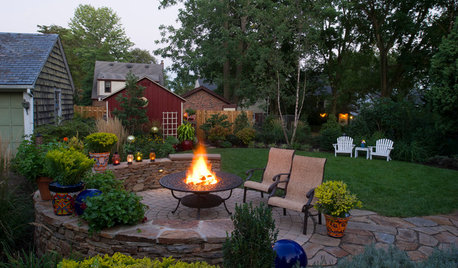Heat with a fuel with (almost) guaranteed continuing low price
joyfulguy
19 years ago
Related Stories

ARCHITECTUREWhat’s Fueling Austin’s Edgy Modern Architecture?
A look at the blossoming design scene in Texas’ capital city — and what’s behind all the experimentation
Full Story
GREEN BUILDINGHouzz Tour: Passive House in Vermont Slashes Heating Bills
Its ecofriendly, low-maintenance design leaves a family with more time to relax and enjoy the weekend home
Full Story
GARDENING AND LANDSCAPING7 Outdoor Fire Features Fuel the Soul
Spark some backyard bonding with a fireplace or fire pit, taking inspiration from these shining examples of great design
Full Story
GREEN BUILDINGInsulation Basics: Heat, R-Value and the Building Envelope
Learn how heat moves through a home and the materials that can stop it, to make sure your insulation is as effective as you think
Full Story
SELLING YOUR HOUSE10 Low-Cost Tweaks to Help Your Home Sell
Put these inexpensive but invaluable fixes on your to-do list before you put your home on the market
Full Story
REMODELING GUIDESClean-Burning Woodstoves Ignite a Greener Heating Trend
No need to rely on oil or gas to heat your home — new woodstove designs burn cleanly and are beautiful to boot
Full Story
BATHROOM DESIGNWarm Up Your Bathroom With Heated Floors
If your bathroom floor is leaving you cold, try warming up to an electric heating system
Full Story
GREAT HOME PROJECTSHow to Add a Radiant Heat System
Enjoy comfy, consistent temperatures and maybe even energy savings with hydronic heating and cooling
Full Story
FLOORSFloors Warm Up to Radiant Heat
Toasty toes and money saved are just two benefits of radiant heat under your concrete, wood or tile floors
Full Story
KITCHEN COUNTERTOPS7 Low-Maintenance Countertops for Your Dream Kitchen
Fingerprints, stains, resealing requirements ... who needs ’em? These countertop materials look great with little effort
Full StorySponsored


Pooh Bear
joyfulguyOriginal Author
Related Professionals
Palo Alto Solar Energy Systems · Sanger Solar Energy Systems · Easton Solar Energy Systems · Inver Grove Heights Solar Energy Systems · Lewisville Home Builders · Ocean Acres Home Builders · Apex Roofing & Gutters · Brandon Roofing & Gutters · Charleston Roofing & Gutters · Portage Roofing & Gutters · Red Bank Roofing & Gutters · Staten Island Roofing & Gutters · Seguin Roofing & Gutters · Norwood Roofing & Gutters · Colonia Roofing & GuttersPooh Bear
ronmn
bry84
joyfulguyOriginal Author
joyfulguyOriginal Author
bry84
RCMJr
joyfulguyOriginal Author
boltonranger
joyfulguyOriginal Author
boltonranger
RCMJr
boltonranger
joyfulguyOriginal Author
boltonranger
joyfulguyOriginal Author
joyfulguyOriginal Author
boltonranger
joyfulguyOriginal Author
lazypup
bry84
lazypup
bry84
billie_
misoilman
bry84
lucky_p
misoilman
joyfulguyOriginal Author
lazypup
joyfulguyOriginal Author